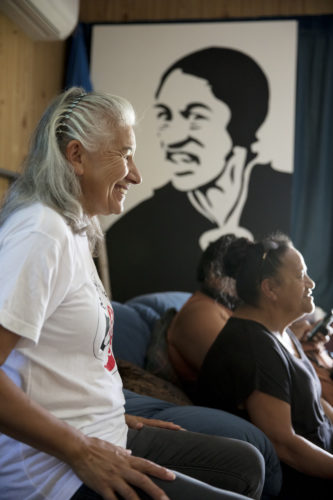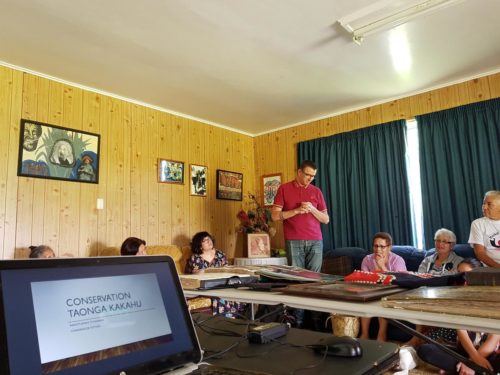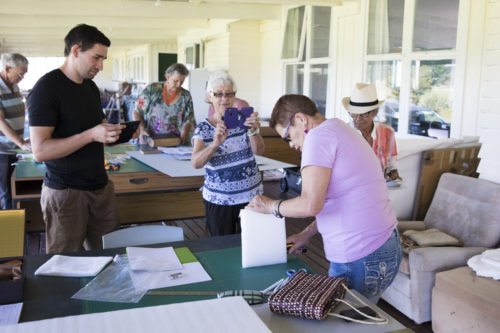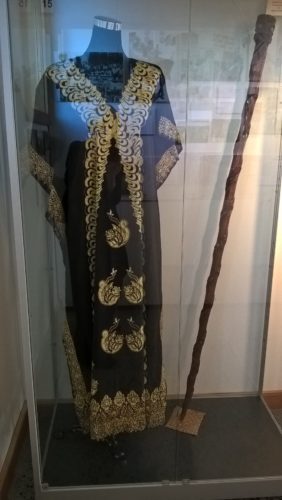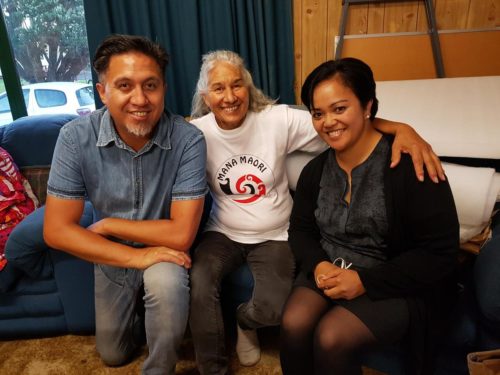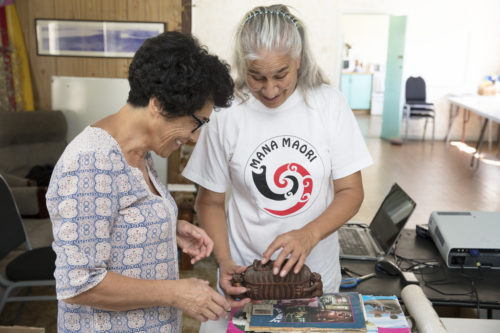By Paora Tibble, Iwi Development Adviser, National Services Te Paerangi
Why do we do what we do? So that iwi, hapū, whānau, museums and galleries can realise the potential of the taonga in their care. Another way of saying this is mana taonga.
Here’s an example of the why, where, when, how and who of what we do:
My colleague Migoto Eria and I were in Raglan for an Iwi Taonga Conservation workshop, where local iwi members could get their taonga assessed by expert conservators and learn how to make storage boxes. The dual purpose of the trip was a photo shoot of Eva Tuaiwa Rickard’s (nee Kereopa) taonga for a future Te Papa press book that looks at protest through objects.
Why?
It was through a presentation that I delivered to the Indigenous Cultural Mapping wānanga in Hamilton that Angeline Greensill, and her son, Ihaia contacted National Services Te Paerangi. They both came up to Wellington, met with the various agencies in the culture and heritage sector to see how they, Tainui Awhiro could best care for their taonga, which includes an extensive archival collection.
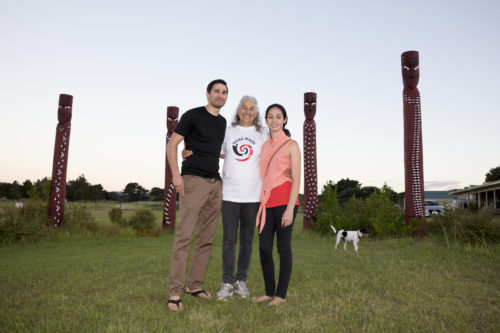
Ihaia, Angeline and Waikauri at Te Kōpua (with Chewy in the background). Photograph Maarten Holl, Te Papa
When, where?
We booked a workshop at the Kōkiri Centre, in Te Kōpua, Whāingaroa (Raglan) for the weekend of 23–25 February 2018.
Who?
Along with the Rickard whānau, we also worked with the amazing people from the Raglan and District Museum Society, including Karyn Willoughby and Ken Soames.
We brought with us the usual suspects, Māori textiles conservator Rangi Te Kanawa and paper conservator Vicki-Anne Heikell. Puawai Cairns (Head of Mātauranga Māori and Curator at Te Papa) came along to work with Te Papa photographer, Maarten Holl, to capture images of Eva Rickard’s taonga.
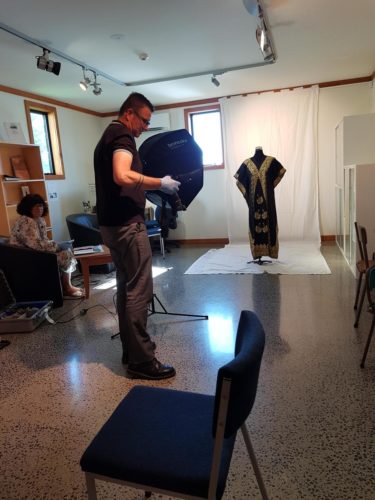
Puawai Cairns and Maarten Holl at the Raglan and Districts Museum capturing images of the dress Eva Rickard wore on the day she was arrested at the Raglan Golf Course, 40 years ago. Photograph by Migoto Eria, Te Papa
We also brought Maarten along, so he could get a feel for how iwi workshops work. He’ll develop a digital photography workshop to support whānau and hapū by showing them how to digitally photograph their taonga – the photos, paintings, carvings and tukutuku that adorn our ancestral houses.
How?
When we got to the museum in Raglan it was late afternoon due to some travel disruptions, but Puawai had been meeting with Raglan Museum Society President, Ken Soames.
Our photographer, Maarten, got straight into his mahi and photographed the dress and pouwhenua of Eva Rickard on display there. I drove off and got a whole suitcase of Eva’s clothing from her daughter, Angeline Greensill. With the help of Puawai and Ken, Maarten did a wonderful job of capturing the kākahu of Tuaiwa. He huruhuru te manu ka tau!
On the Saturday, we began the first day of our workshop with karakia, a mihimihi and presentations. Migoto Eria (Pouwhirinaki ā-Iwi, Iwi Development Manager) shared with the people of Tainui Āwhiro, whowe are, what we do and how we can support their aspirations for taonga. The beauty of working with someone like Migoto is that she’s worked at MTG (Napier), at the Otago Museum as a Māori curator, she’s published books about our taonga and our tīpuna – i.e. she’s experienced.
After myself and Migoto spoke, we handed the rākau kōrero (talking stick) over to our two experts. Here’s where the magic begins to happen.
Rangi Te Kanawa shares the story of three generations of weavers, starting with her grandmother, Rangimārie Hetet, followed by Diggeress Te Kanawa (mum) down to Rangi and her siblings. Wherever we go in Aotearoa, someone knows or has worked with her whānau. In Whāingaroa, the relationship is even closer, Rangi’s brother, Dan, married into the Rickard whānau.
Rangi puts up a powerpoint that illustrates her mahi, the preservation/conservation of textile taonga. A key component of mana taonga is us the staff of Te Papa connecting our people to their taonga in the collections.
Most of the taonga here in Te Papa is unprovenanced. Rangi is researching paru, this is the mud used to dye kākahu. So Rangi collects samples from around the country and the idea is to analyse the paru and see if it matches up with the paru used on kākahu in the collection here at Te Papa.
Mana taonga doesn’t just relate to the collection here in the Museum of New Zealand, it’s also a mechanism by which we can work with communities outside of the institution. Rangi had this beautiful quote, ‘Harakeke is in our whakapapa …’. The way Rangi weaves her kupu, mātauranga and her mahi connects her to whānau, hapū and iwi.
Vicki-Anne Heikell followed with a detailed presentation on the care of paper based taonga. Highly organised, Vicki-Anne also passes around samples of the different types of paper that our tīpuna may have written on.
Vicki-Anne has been doing this mahi for over 20 years. She’s experienced and really knows her way around paper taonga. She also does a workshop on best practise when it comes to the care of the whakaahua that hang in our whare puni.
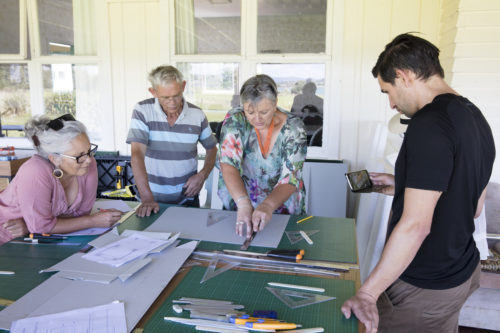
Vicki-Anne showing Katerina Mataira, Owen and Ihaia Greensill how it’s done. Photograph Maarten Holl, Te Papa
Working with mātanga (experts) like Vicki-Anne and Rangi is a real privilege. My work is about connecting with grassroots people who want to make a difference in the care of their taonga. When the dots are finally joined up, it looks like this.


